Coral snakes are mostly found in the Southern United States. Snakes in these regions grow to a length of up to 60 inches and they can be identified by a tricolored body.
While coral snakes can sometimes can only 2 distinct colors, they are almost always found in 3 colors and variations of yellow/white, red, and black.
Coral snakes found in the US typically exhibit either yellow or white bands or rings around their bodies.
Table of Contents
What Are Coral Snakes
Coral snakes are small slender species known for their vividly-colored bodies and dangerous venom.
These are among the most venomous snakes in the world, second only to rattlesnakes.
Coral snakes can be categorized by commonality, coloring, habits, and geography.
The most common type of coral snake categorization is by geographic location. New World and Old-World coral snakes refer to the species found in North and South America while the Old-World coral snakes are those found in Asia.
New World snakes have similar physical traits, with some exceptions. Old World coral snakes also have distinct features.
Coral snakes in the New World are rather short and slender. While they can grow longer, many of these snakes measure around 18-20 inches.
Coral Snake Identification
Coral snakes are easily identified by their bright-colored bodies. US coral snakes are rather short and vividly colored.
Since these snakes are venomous, they are feared by many animals. Their venom is also the reason why other snakes mimic their colored looks even if they aren’t venomous.
Colors and Patterns
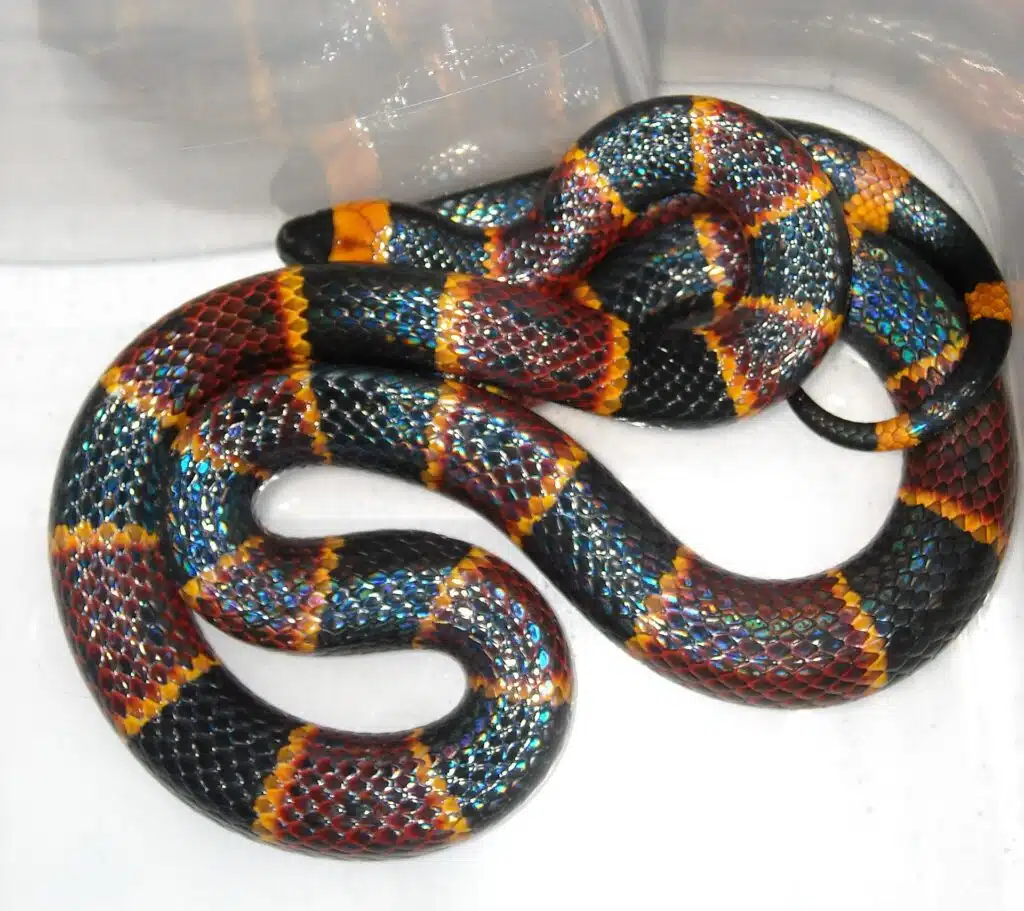
Coral snakes are identified by their colorful bodies. These snakes are mostly red, black, and yellow or white.
There are various combinations and shades of these colors that the snakes can be identified by.
However, the head and the way the colorful bands look are the recommended coral snake identification techniques.
The head of coral snakes is black. The colorful white or yellow bands of the snake run around the body creating a circle. Many other snake species have a completely different belly color (typically lighter).
Behavior
Coral snakes might be venomous but they aren’t as dangerous as first perceived. These are snakes that live underground, mostly coming out to feed or to warm up in the sun.
They are found under tall grass, under leaves, and other debris. These snakes aren’t aggressive showcasing an elusive behavior in the presence of humans.
While the snake can bite people, this aggressive behavior is rare and counteracted with antivenin.
There are no recorded deaths following Coral snake bites in the US over the past few years.
Habitat and distribution
Most Coral snakes in the US are found in forests and deserts such as the Sonoran Desert. These snakes are nocturnal and even hard to spot during the day.
They live underground in burrows or under leaves. Other times they prefer to hide under rocks.
Snakes That Look Like Coral Snakes
The vivid coloring of Coral snakes is distinct. However, there are many other snake species that look at least partially similar to Coral snakes.
1. Texas long-nosed snake
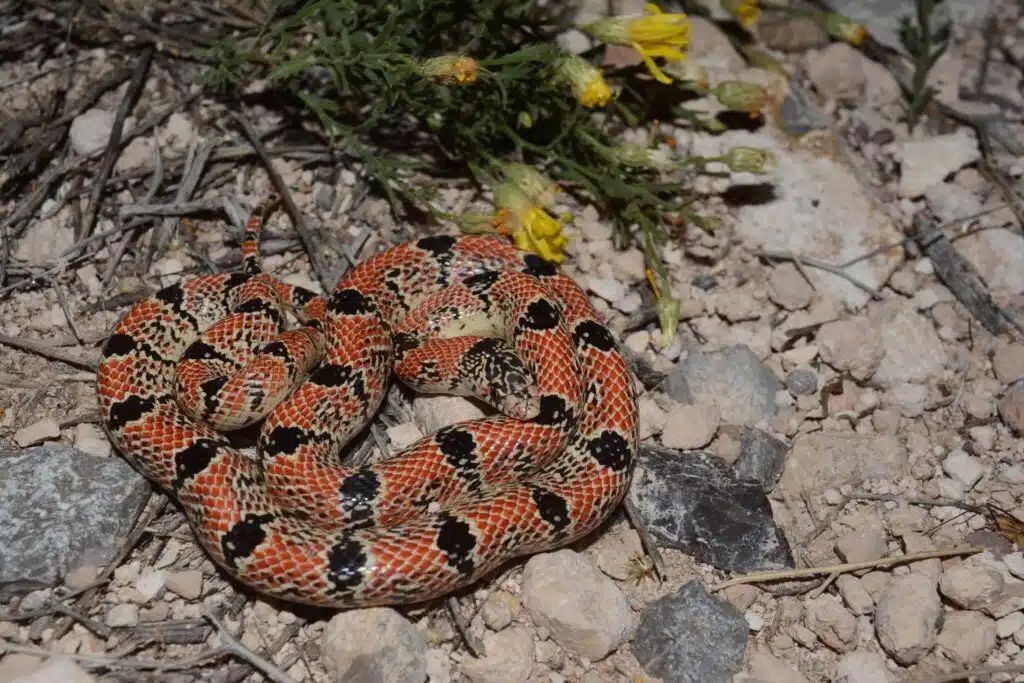
This snake (Rhinocheilus lecontei tessellatus) is often confused with the Coral species.
It resembles Coral snakes in its coloring. With 3 colors it sometimes appears as a Coral to beginners.
The Texas long-nosed snake even has a similar length to Coral snakes, mostly growing to a length of around 30 inches.
However, there are a few key differences that help its correct identification.
It has red, black, and white bands on its body. Its head is also made out of these colors and it’s not black towards the front section of the head as the Coral snake.
The Texas long-nosed snake also has a white belly which means its tricolored bands aren’t forming a circle around its body as on Coral snakes.
2. Scarlet Kingsnake
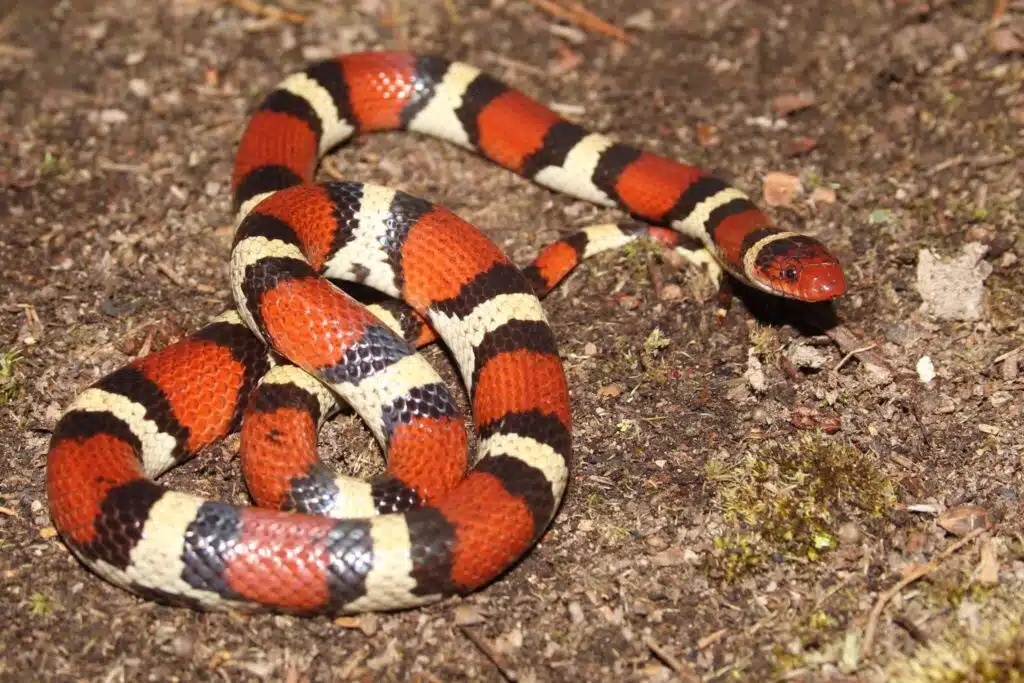
Since it’s so similar to the Coral snake a distinction needs to be made mainly by the color of its head. The Scarlet Kingsnake has a red head which means it’s not a Coral snake.
The Scarlet Kingsnake is also not venomous as Coral snakes are. It has a red head which is the biggest physical difference to the Coral snake.
Snakes of these species are known to exhibit Batesian mimicry. This is a type of mimicry which involves non-venomous species that mimic venomous animals to appear more dangerous.
3. Arizona mountain kingsnake
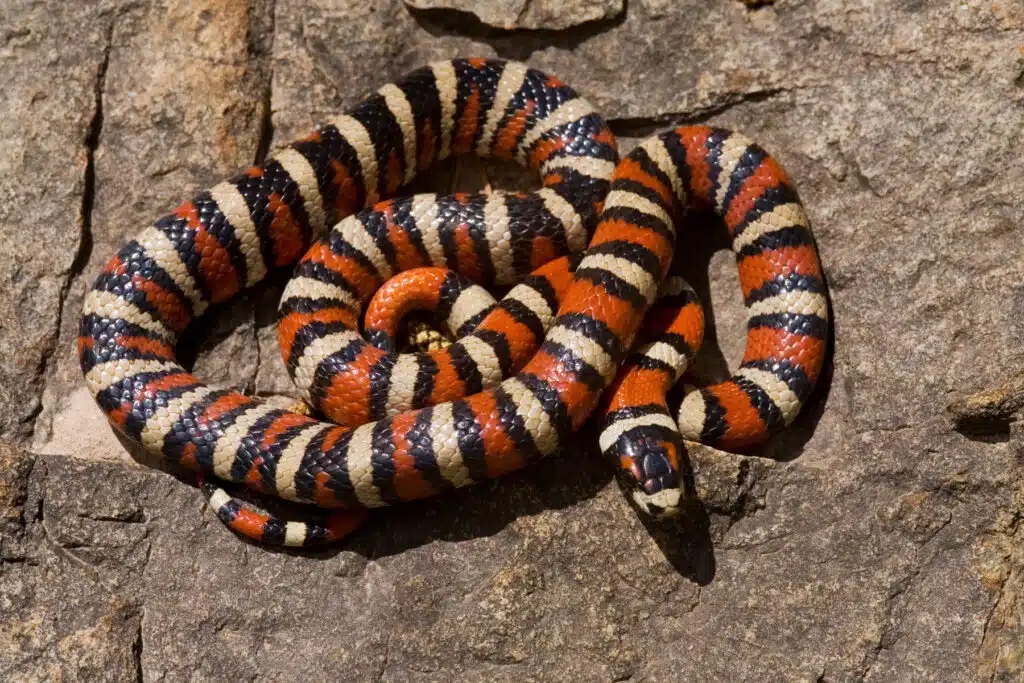
The Arizona mountain kingsnake (Lampropeltis pyromelana) looks very similar to Coral snakes as well as to Scarlet kingsnakes.
It exhibits a mostly red body with black and white bands. There are also a few snakes that have yellow bands instead of white bands to resemble Coral snakes further.
One of the first signs of an Arizona mountain kingsnake is its white head. It has a white mouth and white coloring until the eye line while the rest of its head is black.
This snake is also thicker than Coral snakes which are known for their slender body.
Otherwise, its tricolored bands run around its body in complete circles, just as in Coral snakes.
4. Milk Snake
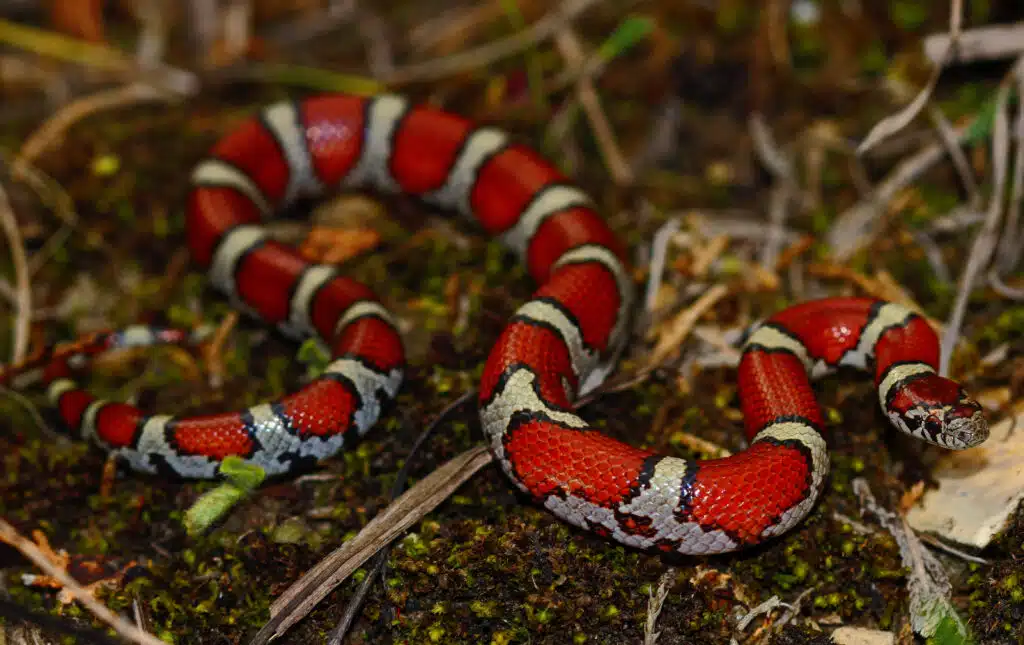
The size of the body is the biggest difference between Milk snakes and Coral snakes. It’s generally accepted that most people cannot differentiate Milk snakes from Coral snakes due to their high resemblance.
With tricolored bodies, Milk snakes (Lampropeltis triangulum) can have a red head or a black head, which makes species identification even more complicated.
Milk snakes are mostly red when juvenile. Many people kill juvenile Milk snakes mistaking them with copperheads.
However, some Milk snakes have a Y sign on their belly while others look exactly like Coral snakes in coloring.
The length of this snake should eventually give it away. Milk snakes grow to 70 inches easily, almost twice as long as Coral snakes.
Milk snakes aren’t venomous either, they just mimic the Coral snake for defense purposes.
5. California Mountain Kingsnake
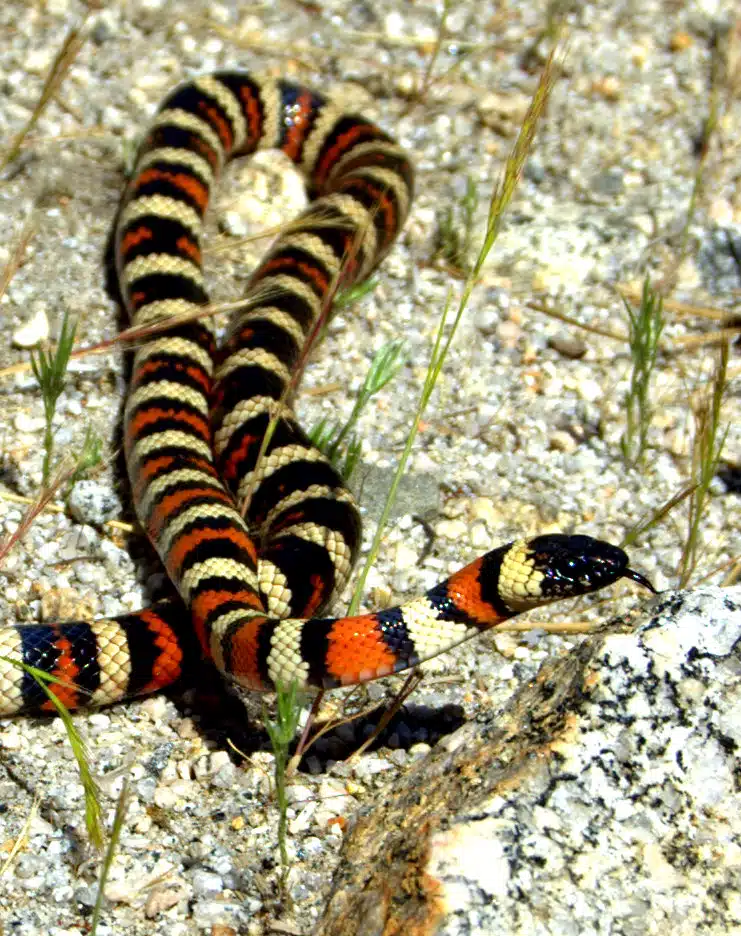
The California Mountain Kingsnake (Lampropeltis zonata) is very similar in appearance to Coral snakes. The biggest difference between these species is found in their habits.
While the Coral snake is nocturnal, the California Mountain Kingsnake is diurnal. It hides in burrows or it even climbs on trees during the day.
The California Mountain Kingsnake is completely harmless as it isn’t venomous. Endemic to the US, this species mimics Coral snakes closely.
It features wide red body bands with black and white marginal bands running along its body. Its head is completely black, just like in most Coral species.
The tricolored nature of this snake helps confuse its predators. They often walk away thinking the California Mountain snake is a Coral snake.
6. Scarlet Snake
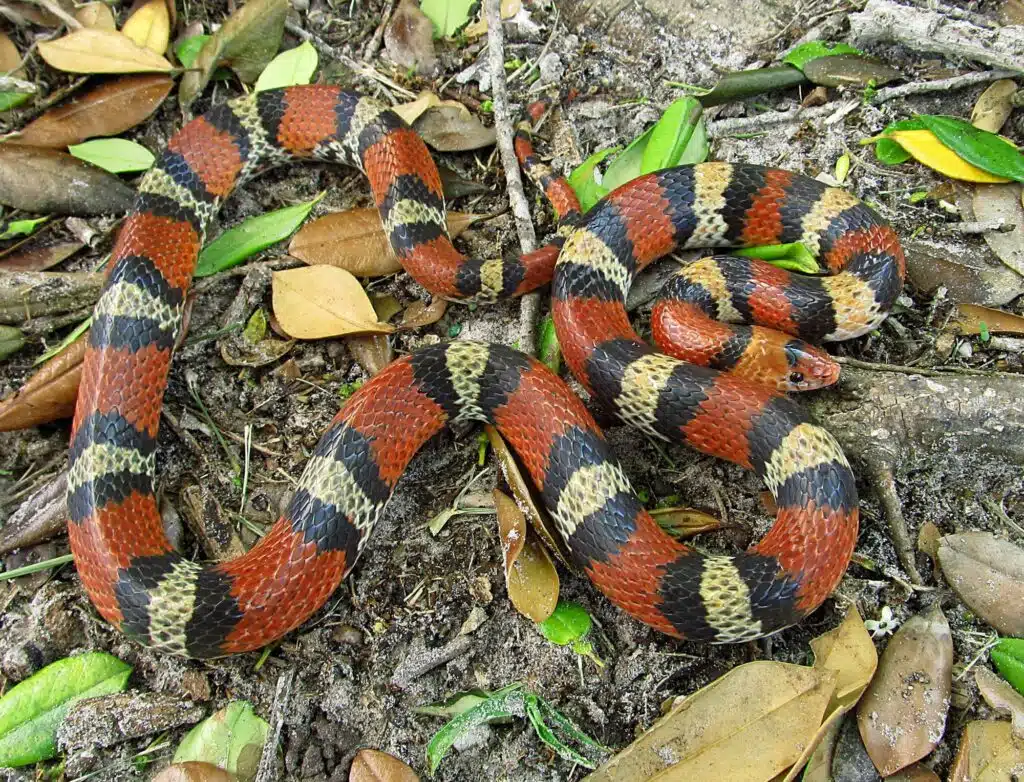
The Scarlet Snake (Cemophora coccinea) is very similar to Coral snakes in both size and coloring. It grows to a full length of just over 20 inches, a few inches more than Coral snakes.
The main difference between tricolored Scarlet and Coral snakes is the coloring of the belly.
Scarlet snakes have a white or light gray belly while the Coral snake has the same coloring and patterns all around its body.
The second main difference between how these species look is the coloring of the head. While Coral snakes have a black head the Scarlet snake has a red head.
7. Gray-banded Kingsnake
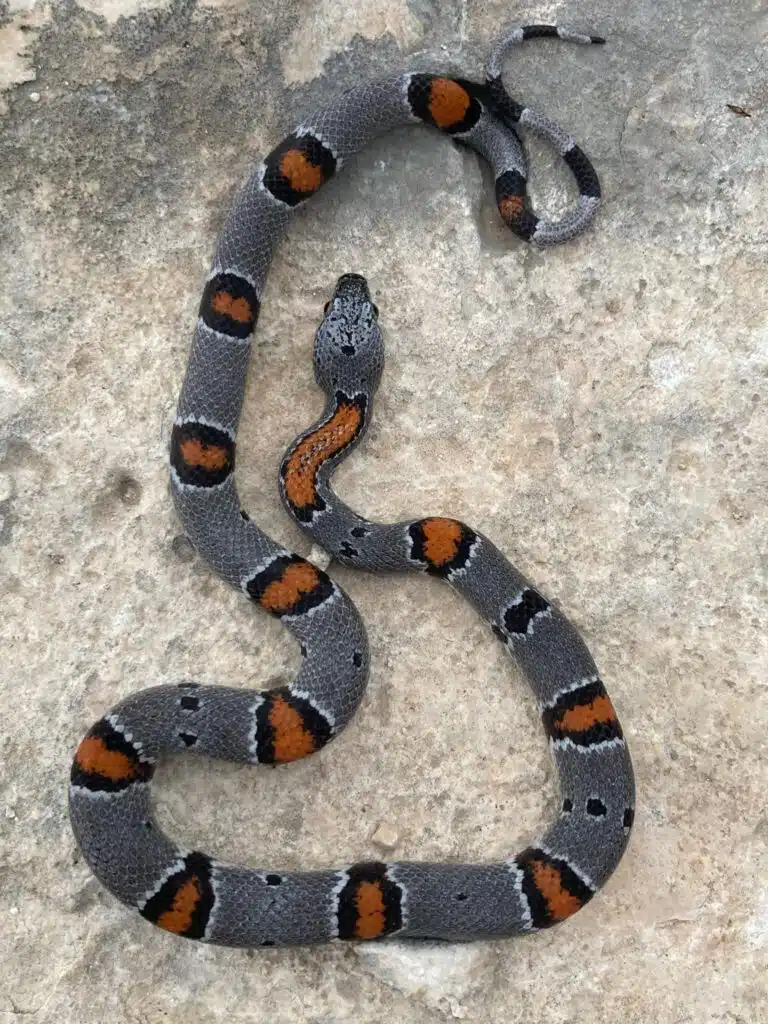
The Gray-banded Kingsnake (Lampropeltis alterna) has some level of similarity to the Coral snake. As its name suggests, it has a gray-banded body with orange and black bands running around its entire circumference.
The first difference between this similar snake and Coral snakes is its gray color body, a color that isn’t seen on Coral snakes.
The second-largest difference is the size of the Gray-banded Kingsnake compared to the size of the smaller Coral snake.
Gray-banded snakes grow to a size of 4 feet, making them at least 3 times larger than the average Coral snake.
The head of the Gray-banded Kingsnake also gives it away. Its gray head is only partially characterized by black marks while Coral snakes have a full black head.
Like many other snakes that look like Coral snakes, the Gray-banded Kingsnake isn’t venomous either.
8. Resplendent Desert Shovel-Nosed Snake
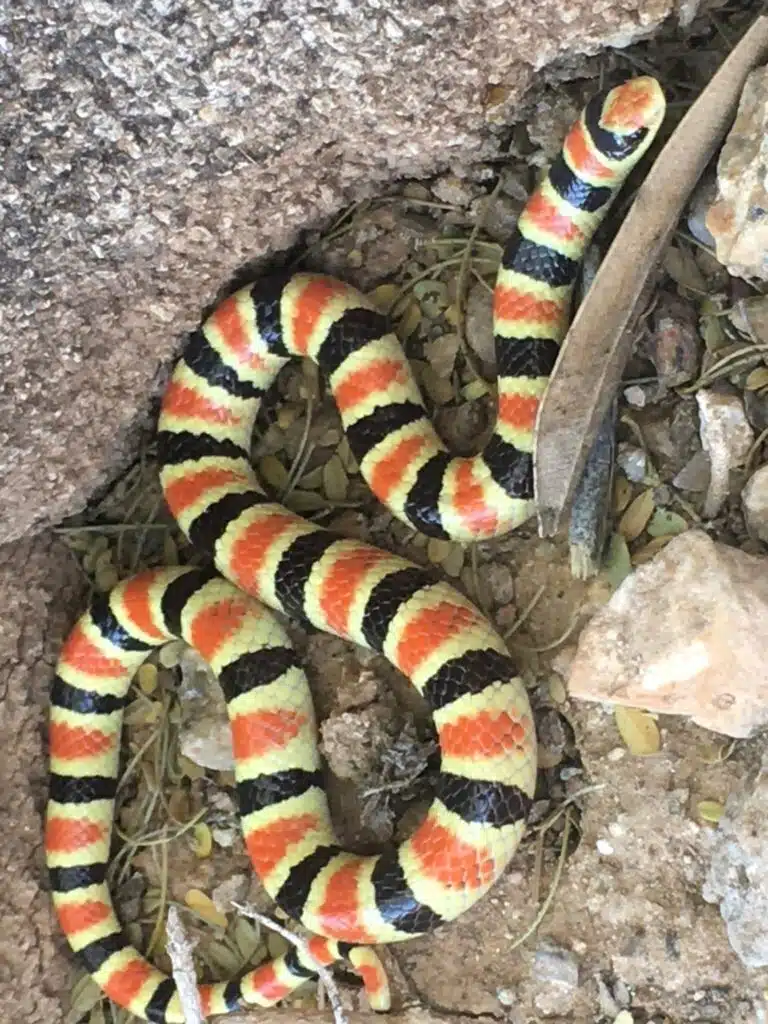
Found in Southern California and across the border in Mexico, the Resplendent Desert Shovel-Nosed Snake (Chionactis annulata) also resembles Coral snakes.
One of the main factors that sometimes make people wrongly identify it as a Coral is its habit as a nocturnal snake, just like most Coral snakes.
While it comes out to hunt scorpions and rodents at night, the Resplendent Desert Shove-Nosed Snake isn’t entirely similar to Coral snakes in coloring.
A white-yellow body with orange and black stripes characterizes this species. However, its bands don’t run across the body and on the abdomen as they’re only visible on its upper part.
The head of this species is also white-yellow as opposed to black.
9. Texas Scarletsnake
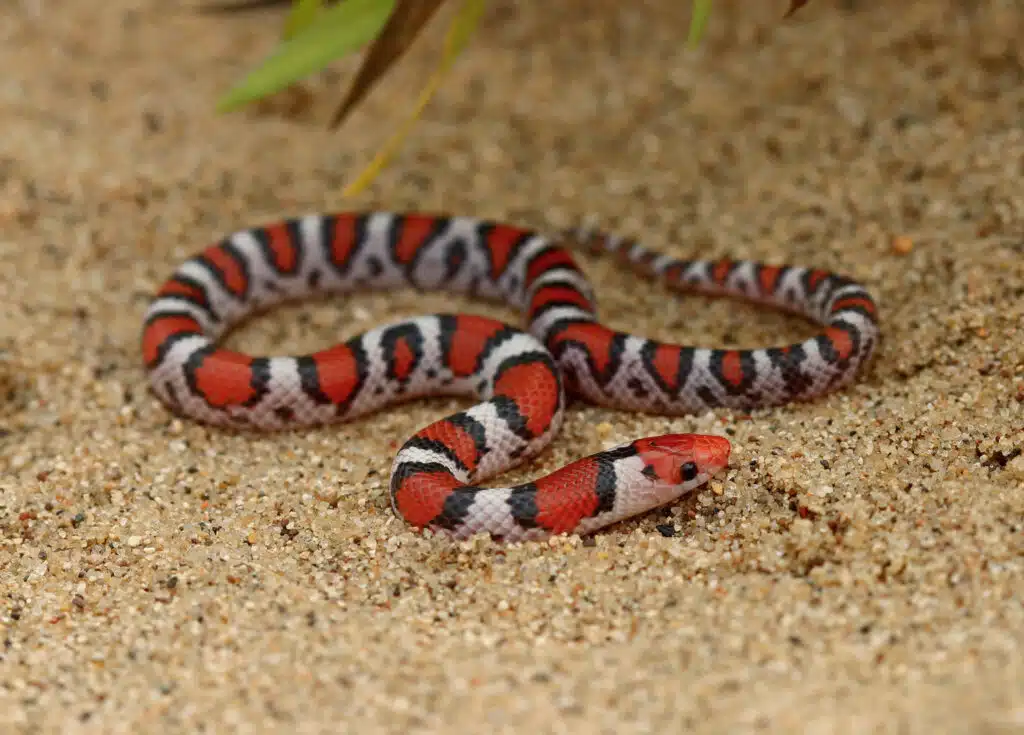
Previously considered a subspecies of the Scarlet Snake, the Texas Scarletsnake (Cemophora lineri) grows larger, to a size of around 26 inches.
This snake has a black and red head with a red mouth. It has a red and gray body with black bands interrupted on the belly, unlike the uninterrupted bands forming perfect circles on the Coral snake.
10. Thornscrub Hook-nosed Snake
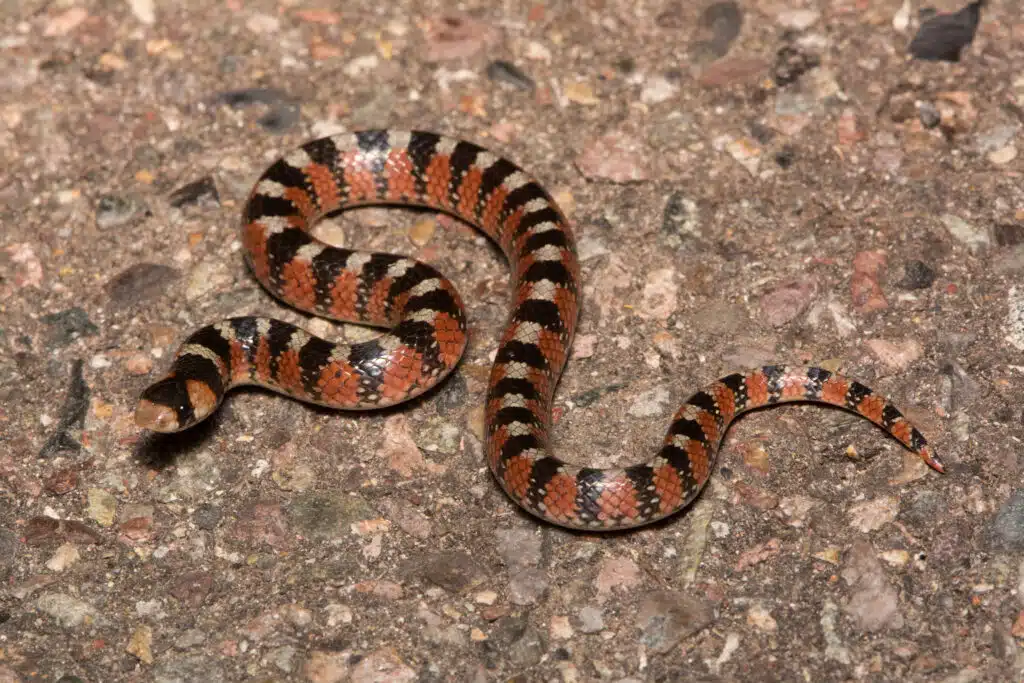
This species (Gyalopion quadrangulare) is also not venomous. It resembles venomous Coral snakes to a large extent, however.
It has a red-brown body with dark brand bands and black bands running along the dorsally. These bands are interrupted on the belly, however.
These snakes mostly eat spiders and occasional centipedes, but they aren’t venomous.
Most Thornscrub Hook-nosed snakes live in the Southwestern parts of the US.
11. Saddled Leafnose Snake
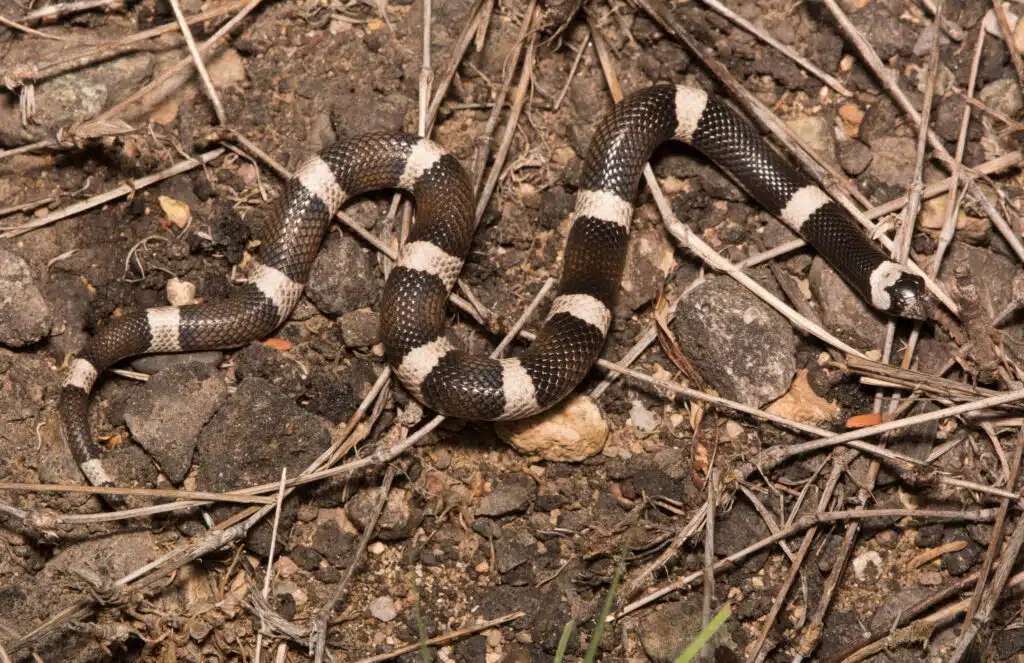
The Saddled Leafnose Snake (Phyllorhynchus browni) has multiple colors. All of its versions resemble the tricolored Coral snake. Gray and orange coloring is dominant in the species.
Its grey version comes with dark brown hands on the body. Its orange version has white and black bands that are a bit more similar to those of the Coral snake.
There’s also a dark brown version of Saddled Leafnose Snake. This version is known for mostly exhibiting a dark brown body with thin black bands and wider off-white bands running along its body.
The head of the brown Saddled Leafnose Snake is brown as well.
12. Sonoran shovelnose snake
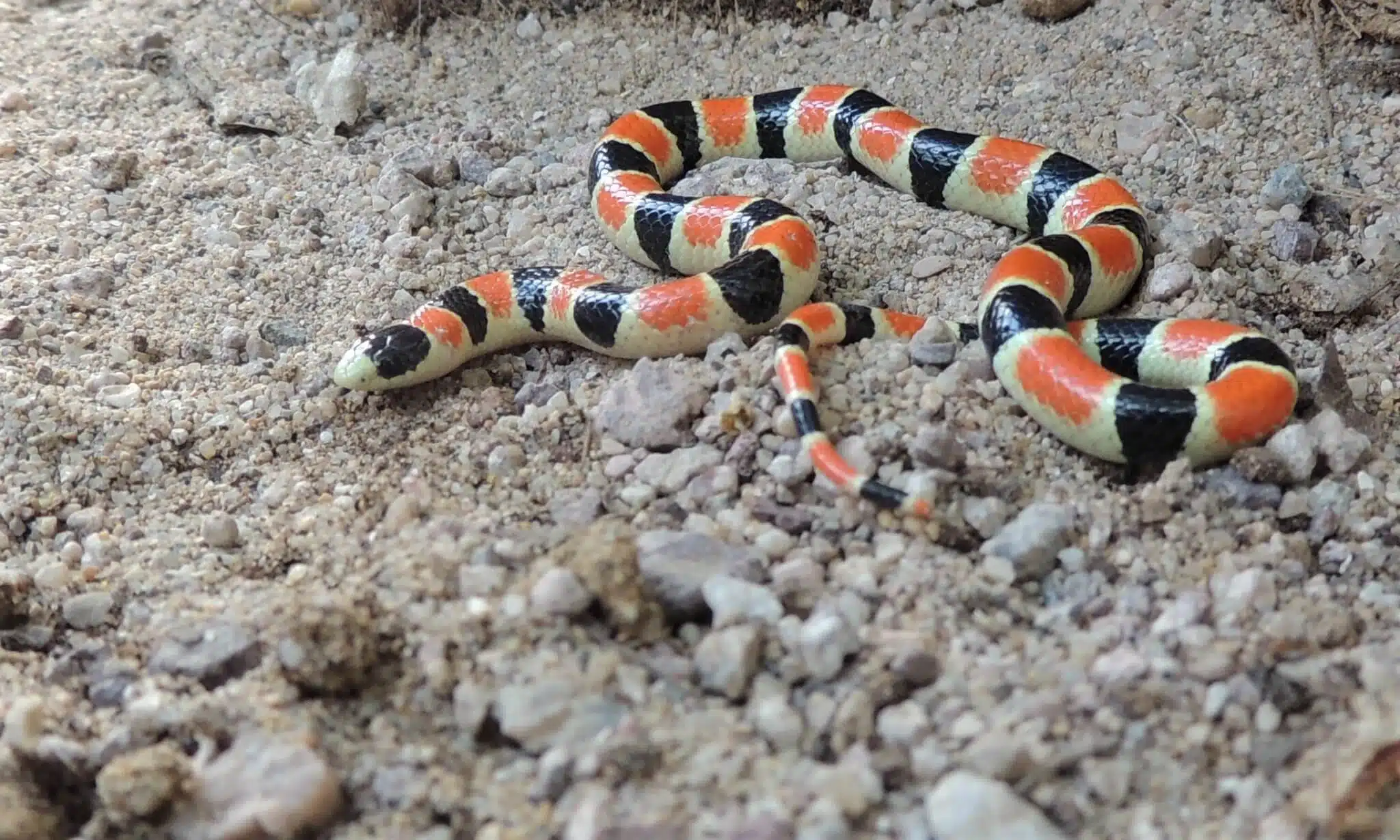
The Sonoran shovelnose snake (Sonora palarostris) is found in the extreme South of Arizona state as well as in the Sonora Desert South of the border.
It can sometimes be spotted around the Organ Pipe Cactus National Monument in Arizona.
The species is described as tricolored, which means it has 3 colors, just as many Coral snakes.
These colors are white, red, and black. The snake is characterized by a mostly white body with red and black bands that aren’t visible on its belly which is all-white.
While only present in a small area of the US, this species is widespread in Mexico.
In the US, it can be seen in Pima County while it’s more common in the Sonora state of Mexico.
Summary
Coral snakes are mostly known for their venomous nature. These snakes have a painful bite which is second on the pain scale of snake bites.
This makes them feared and sometimes misidentified with other species which mimic its look to get away from enemies.
A tricolor body characterizes this snake. Some species such as those listed above mimic its tricolored look to inspire fear or to simply get away from the enemies quicker since most aren’t venomous.
Most snakes that look like Coral snakes have a banded body with colors such as red, white, and black.
A small percentage of snakes that look like Coral snakes have a black head. An even smaller percentage of snakes that look like Corals are as thin and short.
The habits of Coral snakes are also mimicked by some of these species. Many live in the ground or below leaves and rocks, just like actual Coral snakes.
Further Reading: